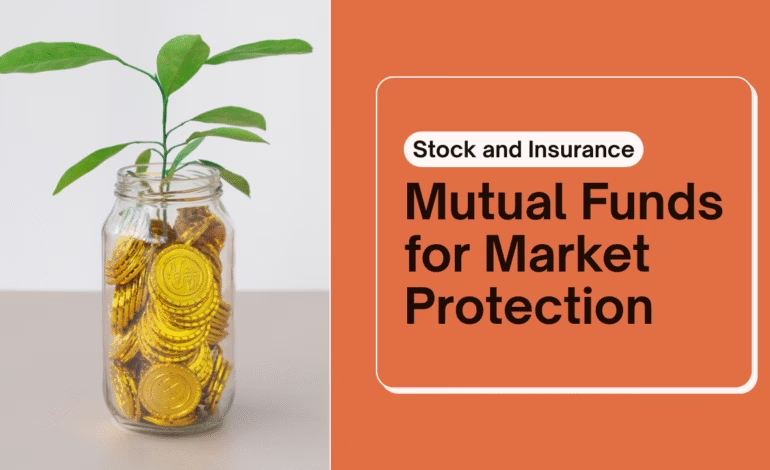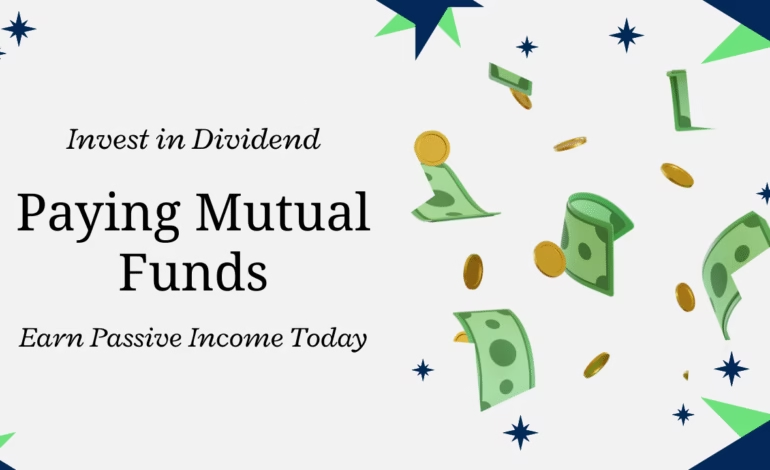
Every investor dreams of a portfolio that not only grows in value but also pays them a steady stream of income. That is where the best dividend paying mutual funds step into the spotlight. Unlike pure growth funds that rely only on capital appreciation, dividend-focused funds combine the benefit of potential market growth with the added cushion of regular income payouts.
But here is the catch. Not all dividend funds are created equal. Some deliver consistent income but lag in growth, while others balance both income and capital appreciation. Choosing the good dividend paying mutual funds becomes crucial, especially in volatile global markets where investors seek stability alongside growth.
Many investors often debate whether to go with index funds or mutual funds for steady returns. If you want a deeper breakdown of the differences, you can check my detailed blog on Index Funds or Mutual Funds: Which Is Better? for a broader comparison.
Why Dividend Mutual Funds Are Becoming Popular in 2026
Markets across the US, UK, Canada, Singapore, and Australia have all seen phases of turbulence in the past few years. Inflation, interest rate hikes, and unpredictable earnings reports often cause stock prices to swing dramatically. For investors, that volatility creates uncertainty. Dividend mutual funds provide a sense of reliability by paying out income even when market prices fluctuate.
For instance, if you held a broad-market growth fund during a downturn, you might see red across your portfolio with no cash flow. But with a dividend-paying mutual fund, you would still receive distributions that help you stay invested without panic selling. This psychological safety net is as valuable as the actual income itself.
What Exactly Are Dividend Paying Mutual Funds?
Dividend mutual funds pool money from many investors and invest primarily in companies that regularly distribute dividends. These companies are usually well-established, financially stable, and often leaders in their industries. Think of names like Johnson & Johnson, Procter & Gamble, or large banks that share profits with shareholders.
Now imagine not just holding a single company but dozens of them through a fund. The risk of one company cutting its dividend is softened by the diversification of the mutual fund. That is why investors who are building for retirement, financial independence, or passive income often gravitate toward dividend funds.
The Psychology of Dividends: Why Investors Love Them
If you ask seasoned investors in the US or UK, they will tell you dividends feel like a “reward” for staying invested. It is not just about numbers on a screen going up or down. It is about cash actually landing in your account. This cash can be reinvested to compound returns or withdrawn to support living expenses.
Let’s try something interactive here.
Quick Question for You:
Would you prefer receiving $500 in dividend income every quarter from your portfolio, or would you rather let your portfolio grow quietly without any payouts? Drop your answer in the comments. you will be surprised how different investors think about this.
Global Relevance of Dividend Mutual Funds
- United States: Investors often use dividend mutual funds as part of their retirement accounts (IRAs and 401(k)s) because they provide steady income and long-term tax efficiency.
- United Kingdom: Dividend-paying funds are popular inside ISAs, helping investors build income streams that are tax-free.
- Canada: Many Canadian dividend mutual funds focus on banks and energy companies that traditionally offer high dividend yields.
- Australia: Known for its franked dividends, Australian investors enjoy tax credits alongside payouts, making dividend mutual funds highly attractive.
- Singapore: Dividend mutual funds often include REITs (Real Estate Investment Trusts) that deliver consistent distributions from rental income.
Why 2026 is the Perfect Time to Revisit Dividend Mutual Funds
With global economies adjusting post-inflationary cycles, central banks are gradually stabilizing interest rates. This creates a sweet spot for dividend strategies. High dividend-paying companies remain attractive because they offer more predictable returns compared to growth stocks that are still volatile.
Investors are also increasingly blending dividend funds with growth strategies to balance risk. A younger investor in Canada might hold both a technology-focused growth fund and one of the best dividend paying mutual funds for stability. A retiree in Australia, on the other hand, might lean heavily toward dividend income to cover monthly expenses.
While dividend funds are excellent for steady payouts, some investors prefer growth-focused funds for higher long-term returns. I’ve covered this in my blog on Low-Cost Mutual Funds for Developed Market Growth 2026 which can help you compare both strategies.
How to Choose Best Dividend Paying Mutual Funds
Now that we understand the basics, let’s explore how you can actually identify the best dividend paying mutual funds in 2026. Remember, not every fund is built to serve the same purpose. Some are designed for aggressive income, while others strike a balance between income and growth.
Key Factors to Evaluate Dividend Mutual Funds
- Dividend Yield
- The most common metric investors look at. A fund yielding 3 to 5 percent annually is generally considered attractive. But beware of extremely high yields. sometimes they signal risky holdings or unsustainable payouts.
- Expense Ratio
- Fees matter. Even a difference of 0.50 percent can eat into your income significantly over 10 or 20 years. Always compare expense ratios across funds.
- Consistency of Dividends
- It is not just about how much a fund pays but how consistently it pays. Look for funds with a long track record of stable or growing dividend distributions.
- Underlying Holdings
- The companies inside the fund matter. If a fund is too concentrated in one sector (like energy or financials), it could be vulnerable during downturns. A good dividend paying mutual fund should spread across multiple industries.
- Fund Manager Reputation
- For actively managed dividend mutual funds, the skill of the fund manager makes a big difference. Check if the manager has a strong track record of navigating volatile markets.
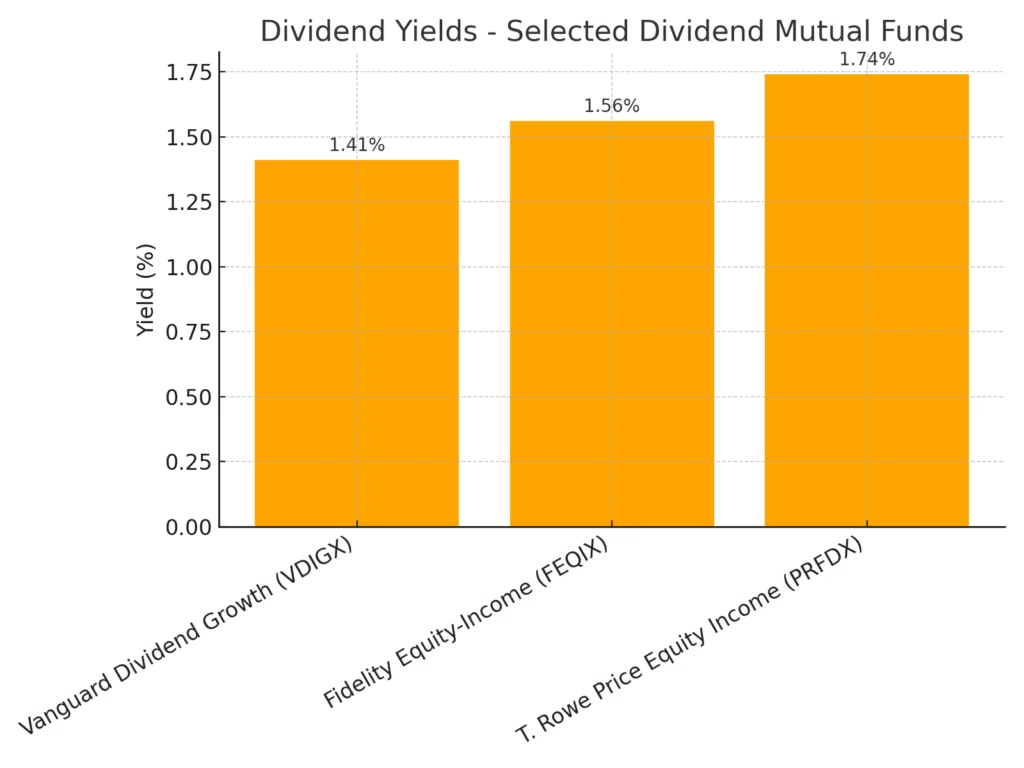
Comparison Table: Dividend Mutual Funds
Here is a simplified comparison to show how different types of dividend mutual funds might stack up:
| Fund Type | Typical Yield Range in Developed Markets | Expense Ratio Range | Best For | Typical Sectors |
|---|---|---|---|---|
| US Dividend Growth Fund | 2.0 % – 3.5 % | 0.10 % – 0.25 % | Income + long term growth | Technology, Healthcare, Consumer Staples |
| Global High Dividend Fund | 3.5 % – 5.0 % | 0.30 % – 0.60 % | Higher income seekers | Energy, Utilities, Global Financials |
| Balanced Dividend Fund | 2.5 % – 4.0 % | 0.25 % – 0.40 % | Stability + moderate income | Consumer Goods, Banks, Defensive Stocks |
| REIT Dividend Fund | 4.5 % – 7.0 % | 0.40 % – 0.70 % | Income + property exposure | Real Estate, Infrastructure, Property Trusts |
Note: Yields change with interest rates, sector performance, and broader macroeconomic conditions. Expense ratios also vary depending on fund size, management style, and whether the fund is actively or passively managed. The figures shown here are example ranges for 2025-2026 and should be taken as illustrative only. For the most up-to-date details on specific funds, please refer to the official Morningstar Fund Fact Sheets.
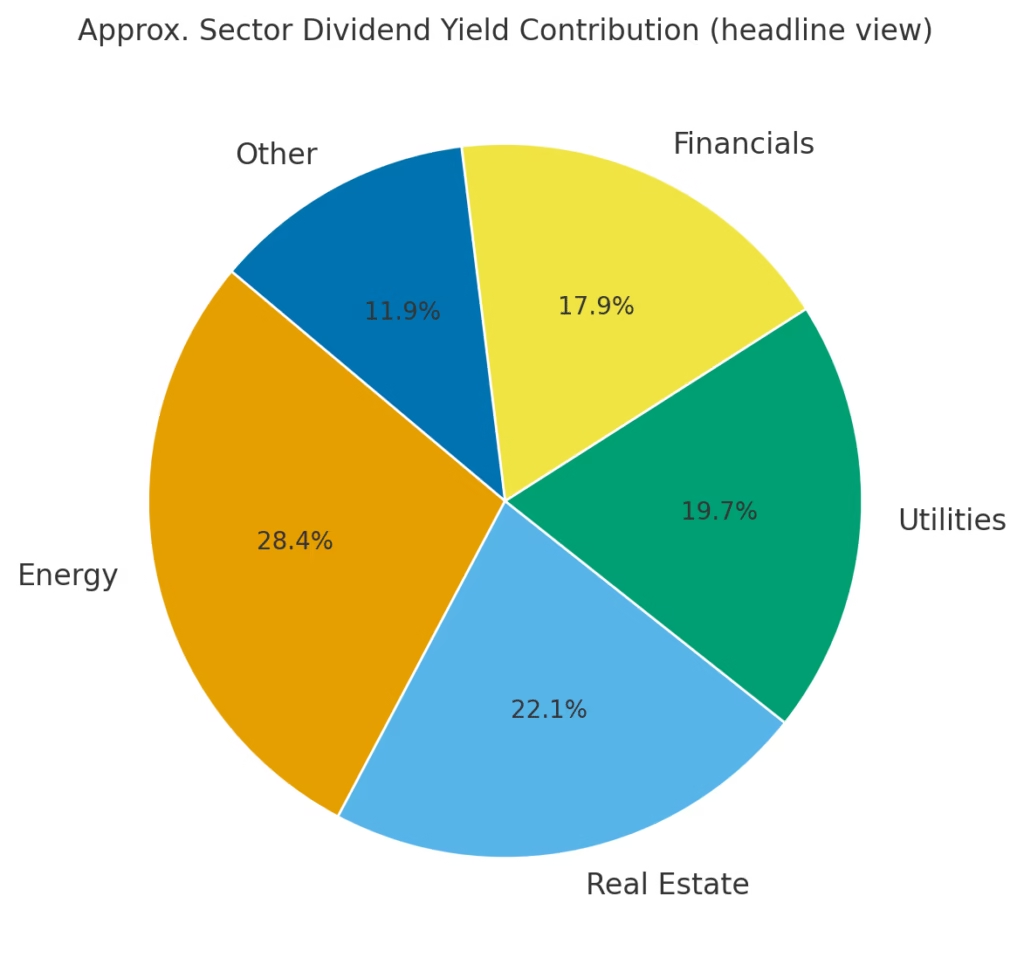
Good Dividend Paying Mutual Funds vs. Best Ones
This is where many investors get confused. A good dividend paying mutual fund may offer reasonable payouts, but the best dividend paying mutual funds go beyond that by balancing income with long-term wealth creation.
Think of it like cars. A good car will take you from point A to B safely. The best car gives you safety, comfort, efficiency, and performance. Similarly, the best dividend mutual funds offer:
- Competitive yields without excessive risk
- Low expenses
- Diversified holdings across sectors and geographies
- A proven track record of stability
For a transparent, data-backed perspective, you can review Morningstar’s Fund Ratings to see how top dividend mutual funds rank in terms of risk and performance.
Practical Example: The Power of Dividend Reinvestment
Imagine you invested $20,000 in a good dividend paying mutual fund with a 3.5% yield. Instead of withdrawing dividends, you reinvest them back into the fund. Over 15 years at a 7% market return, that reinvestment could grow your portfolio to over $55,000.
Now, compare this with withdrawing dividends for spending. You would still have a decent income stream but end up with significantly less growth. This is why many investors, especially in their 30s and 40s, prefer reinvesting dividends, while retirees often withdraw them for living expenses.
By now, you have a clear understanding of what makes the best dividend paying mutual funds stand out from the rest. But knowing is only half the battle. To truly benefit, you need a smart strategy, an awareness of common mistakes, and a clear plan for execution.
Strategies to Maximize Returns from Dividend Mutual Funds
- Reinvest Dividends Early
If you are in your 20s, 30s, or even 40s, reinvesting dividends is one of the most powerful ways to compound your wealth. Instead of cashing out, let the dividends buy more fund units automatically. Over time, this snowballs into significant growth. - Diversify Your Dividend Funds
Avoid putting all your money into a single fund. Mix between US dividend growth funds, international dividend funds, and sector-specific funds like REITs. This spreads out risk and cushions you during regional or sector downturns. - Set Clear Objectives
Ask yourself: Are you looking for income today or wealth growth tomorrow? Retirees may prefer high-yield dividend mutual funds, while young professionals should focus on growth-oriented dividend funds. - Review Performance Annually
Dividend funds should be stable, but markets change. Check annually whether your fund still meets your goals, has kept fees low, and maintained payout consistency.
Common Mistakes Investors Make with Dividend Mutual Funds
- Chasing the Highest Yield: A 7% yield may look attractive but often comes with risky holdings. High yield without stability is a red flag.
- Ignoring Tax Implications: In countries like the US and UK, dividend income may be taxed differently than capital gains. Always check how taxation affects your net returns.
- Neglecting Expense Ratios: Many investors focus only on dividends but ignore fees. A fund charging 1.2% in expenses can eat away a large part of your dividend income.
- Not Considering Inflation: A 3% dividend sounds good, but if inflation runs at 4%, your purchasing power is actually shrinking. Choose funds with both dividend growth and capital appreciation.
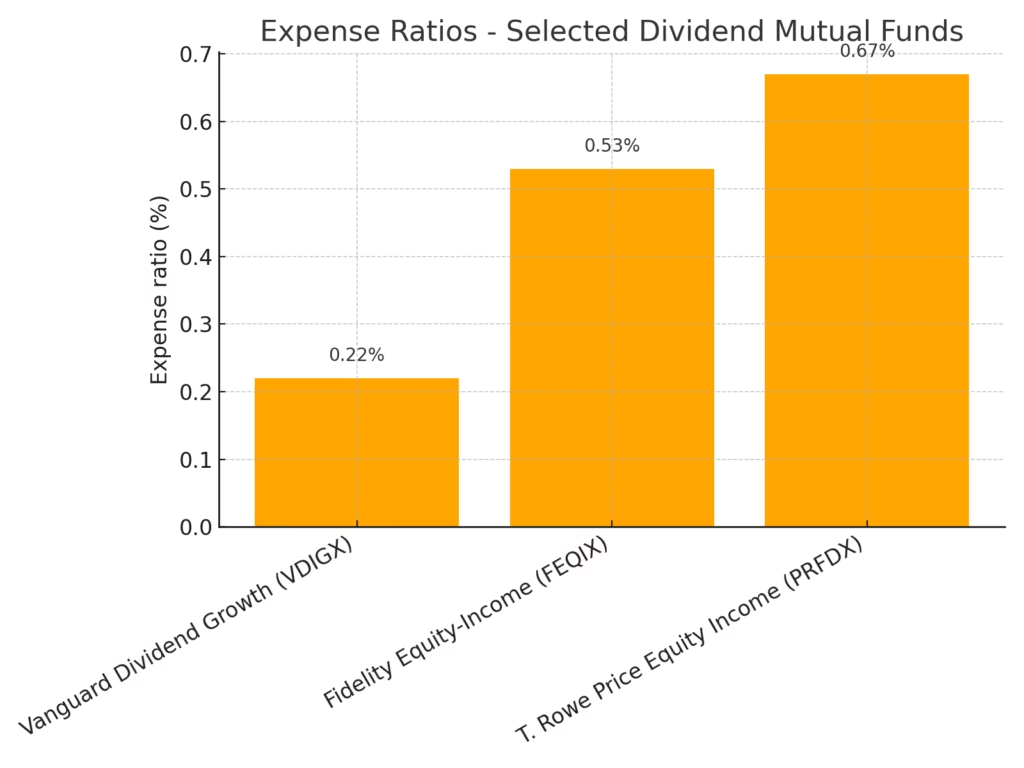
Real-Life Example: Dividend Fund for Retirement
Meet Sarah, a 55 year old professional in Canada. She invested $100,000 in a balanced dividend mutual fund with a 3.5% yield. Instead of reinvesting, she withdraws $3,500 annually to supplement her pension income.
On the other hand, Jason, 30 years old in the US, invests the same $100,000 but reinvests dividends. By retirement age, his portfolio grows exponentially, giving him a mix of capital growth and income security.
This example shows how the benefits of mutual funds in volatile markets vary depending on age, goals, and reinvestment strategy.
FAQs About Dividend Paying Mutual Funds
Q1: Are dividend mutual funds safe?
They are generally safer than individual dividend stocks due to diversification. But no investment is entirely risk-free.
Q2: What is the average dividend yield for good dividend paying mutual funds?
Typically, between 2% to 5%, depending on the type of fund and market conditions.
Q3: Can I live off dividends alone?
Yes, many retirees in the US, UK, and Canada do this. However, you need a sizable portfolio and must balance income with inflation protection.
Q4: Should beginners invest in dividend mutual funds?
Absolutely. They provide stability, predictable returns, and are less intimidating than picking individual stocks.
My Final Thoughts
The best dividend paying mutual funds are not just about chasing high yields. They are about building a stable, consistent, and tax-efficient income stream while also preserving and growing capital.
Whether you are a young investor reinvesting dividends for future wealth or a retiree looking for steady income, dividend mutual funds can be tailored to fit your goals.
The secret lies in balance. Look for good dividend paying mutual funds with strong track records, low fees, and consistent payouts. Diversify across sectors and geographies. Avoid chasing unsustainable yields. And above all, stay invested through volatility.
If you do this, dividend mutual funds will not just protect your wealth but also help you achieve true financial freedom. If you’re new to this topic and want more foundational learning, Investopedia’s How Mutual Fund pay dividend is a solid starting point to build your basics.

